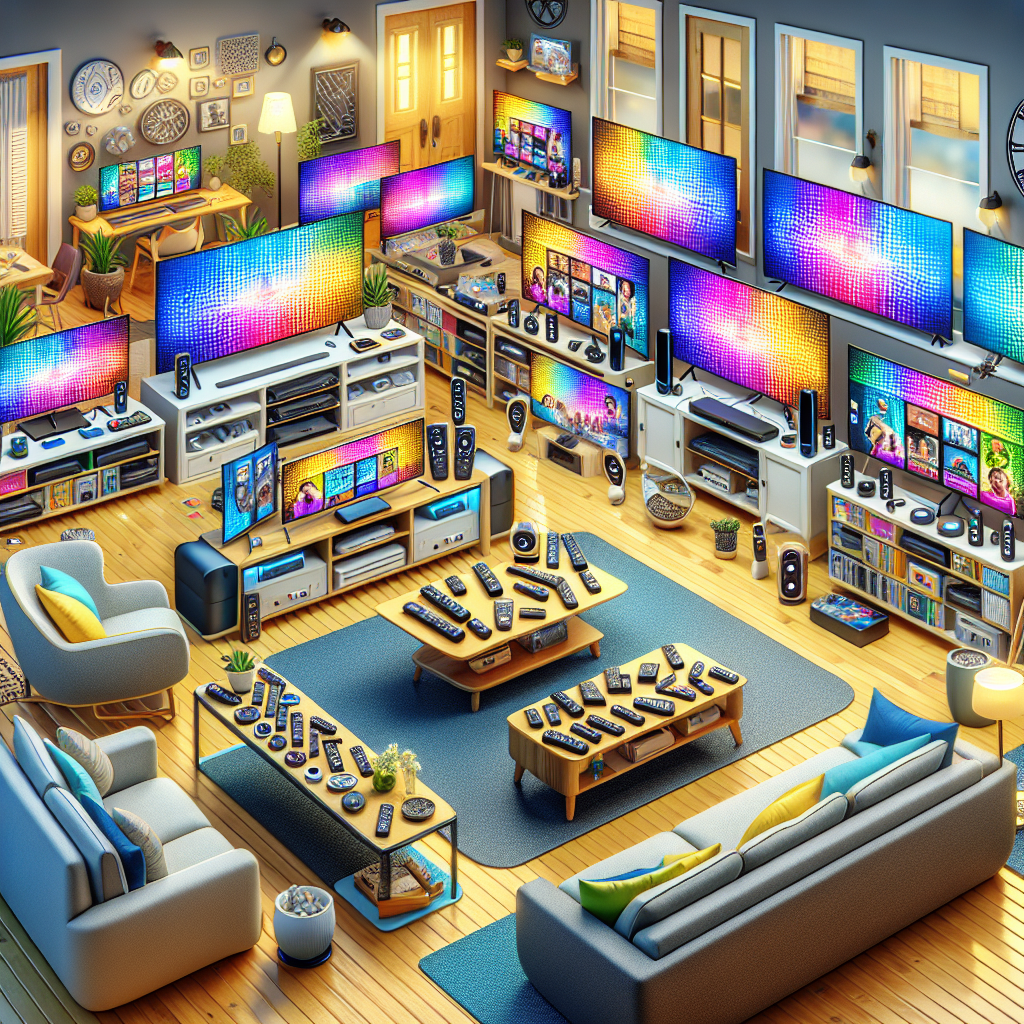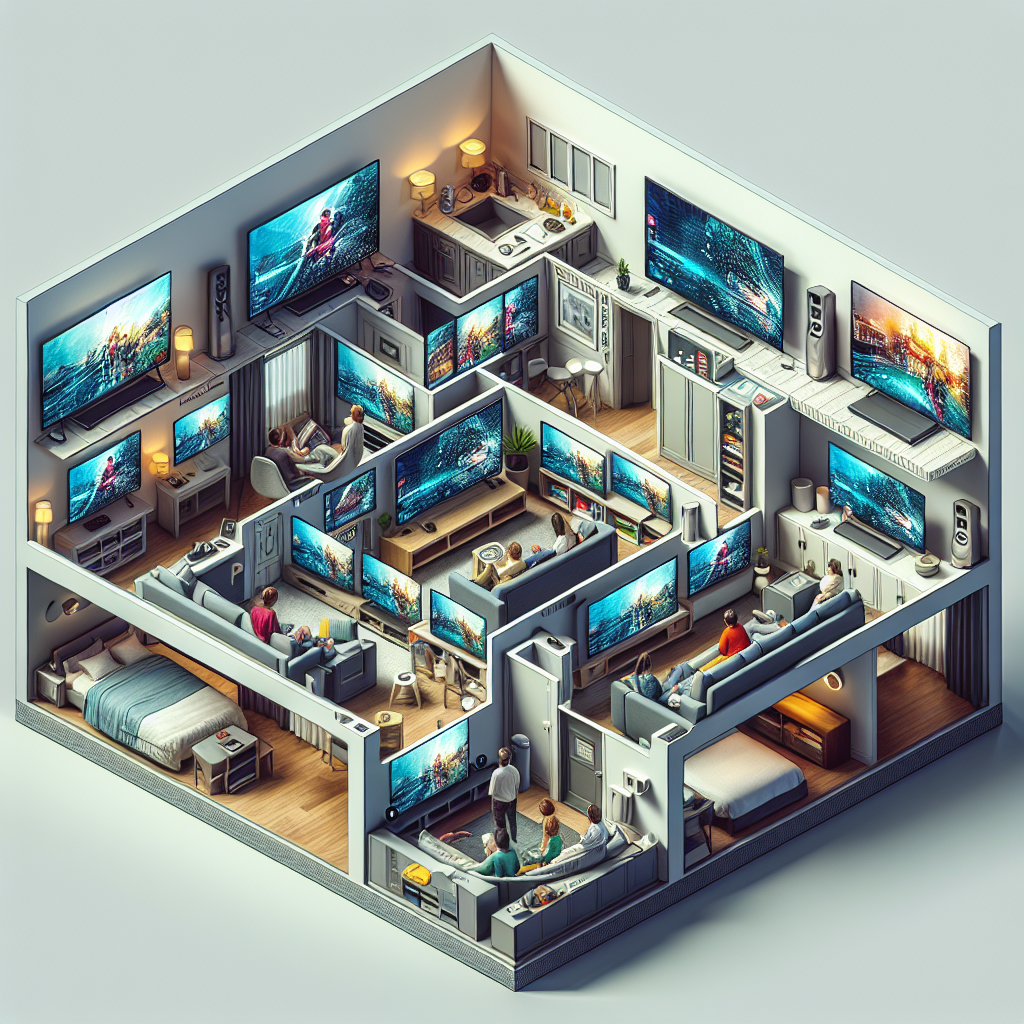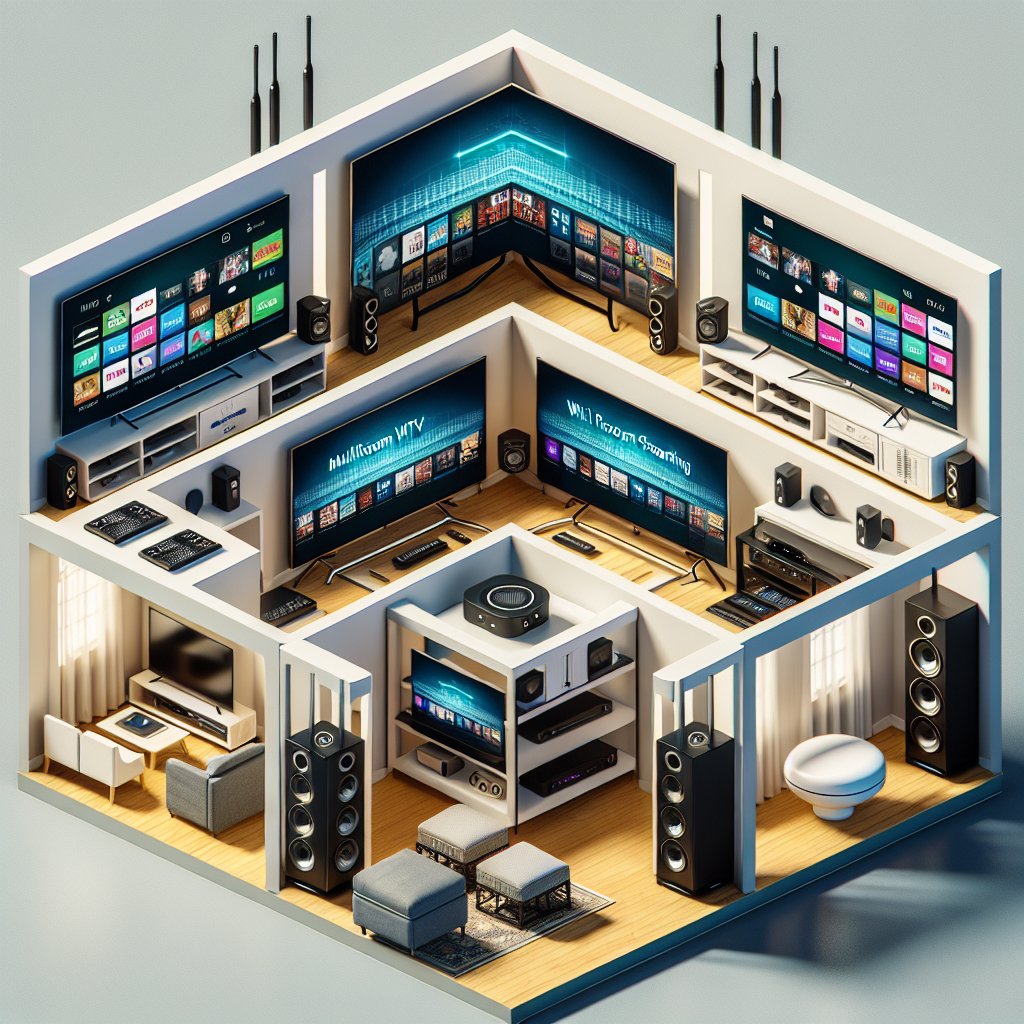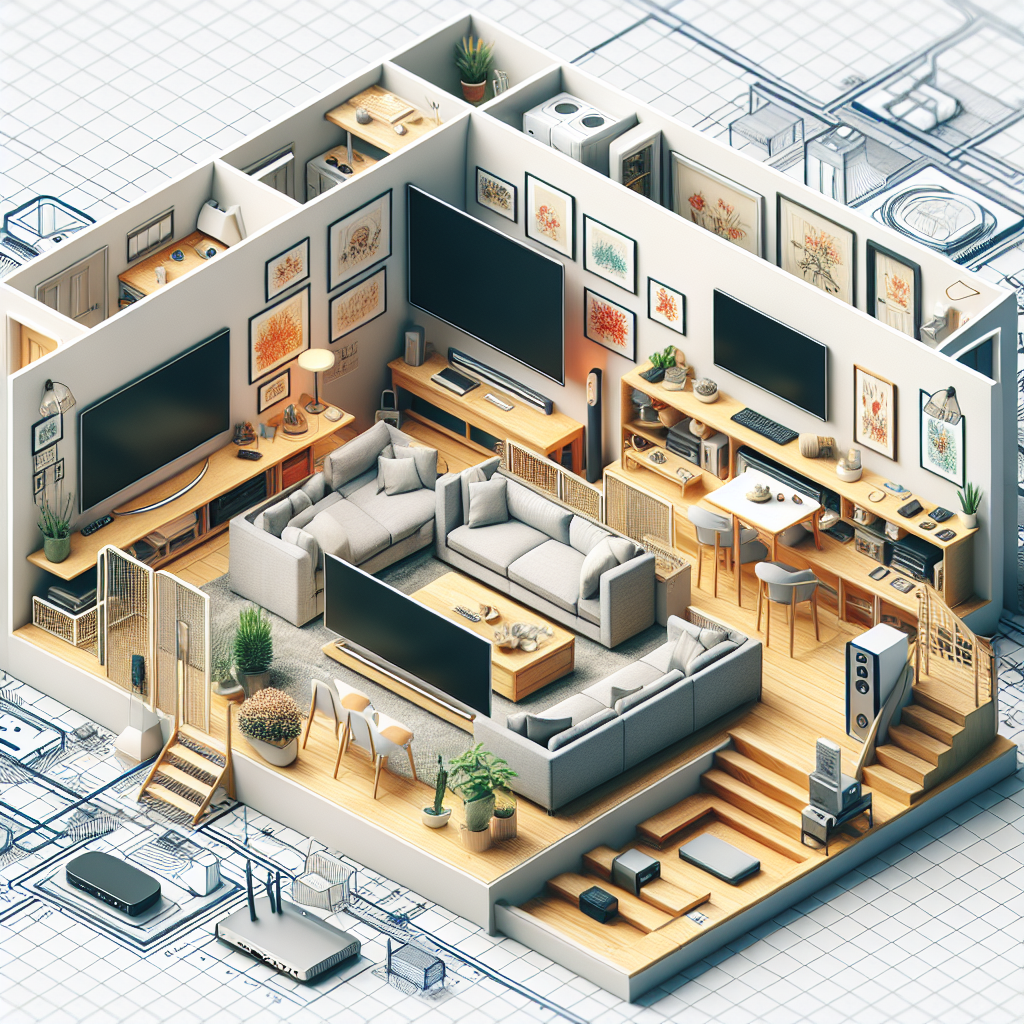Are you tired of arguing over the remote control in your apartment? Do you wish you could watch different shows in different rooms simultaneously? Look no further than a Multiroom Viewing setup for apartments! Say goodbye to TV conflicts and hello to ultimate entertainment freedom with this revolutionary system. In this comprehensive guide, we will walk you through the process of setting up a Multiroom Viewing system in your apartment, allowing you to enjoy your favorite shows in every room without any hassle. Get ready to take your TV experience to the next level with this game-changing technology.
Understanding Multiroom Viewing Systems
Definition of Multiroom Viewing
Multiroom viewing refers to the setup where residents in an apartment can watch the same content simultaneously across multiple rooms or different content in each room. This system allows for a seamless viewing experience without the need for individual setups in each room. By connecting all rooms to a central entertainment hub, residents can enjoy their favorite shows or movies in any part of the apartment.
Benefits of Multiroom Viewing in Apartments
- Convenience: With a multiroom viewing setup, residents can easily move from one room to another without missing out on their entertainment. This is ideal for households where members have different viewing preferences.
- Space-saving: Instead of having multiple devices in each room, a multiroom viewing system streamlines the setup by centralizing the entertainment equipment. This can help save space and reduce clutter in the apartment.
- Enhanced Entertainment Experience: By synchronizing viewing across multiple rooms, residents can create a cinema-like experience within the comfort of their own apartment. This is particularly beneficial for movie nights or watching sports events with friends and family.
Planning Your Multiroom Viewing Setup

Assessing Your Apartment Layout
When planning a multiroom viewing setup for your apartment, a crucial initial step involves assessing the layout of your living space. This assessment is vital to ensure optimal placement of equipment and seamless connectivity throughout the various rooms.
Considerations for Apartment Size and Layout
- Room Size: Evaluate the dimensions of each room in your apartment to determine the suitable screen size for optimal viewing experience. Larger rooms may require bigger screens to maintain visibility from different angles.
- Wall Outlets: Identify the location of electrical outlets in each room to facilitate the setup of TVs, streaming devices, and any additional equipment required for multiroom viewing.
- Furniture Placement: Take into account the positioning of furniture such as couches, tables, and cabinets to avoid obstructions that may impede the viewing experience or block signals from remote controls.
Identifying Suitable Rooms for Multiroom Viewing
- Main Living Area: Consider designating the main living area, such as the living room or lounge, as the central hub for your multiroom viewing setup. This room typically accommodates the primary TV and entertainment system.
- Bedrooms: Assess the feasibility of extending the viewing experience to bedrooms within your apartment. Determine if there is adequate space and suitable viewing angles to install additional TVs or streaming devices.
- Study or Home Office: If you have a dedicated study or home office space, explore the possibility of integrating it into your multiroom viewing setup. This room could serve as a secondary viewing area for enhanced entertainment options.
By carefully evaluating your apartment layout based on these considerations, you can effectively plan and implement a multiroom viewing setup that caters to your viewing preferences and enhances the overall entertainment experience in your living space.
Selecting the Right Equipment
When setting up a multiroom viewing system in your apartment, selecting the appropriate equipment is crucial to ensure seamless connectivity and optimal viewing experience. Here are some key considerations to keep in mind:
Types of Devices Needed for a Multiroom Viewing Setup
- Television Sets: The central component of your setup, each room will require a television set capable of connecting to your chosen streaming services or cable provider.
- Media Players: Devices such as smart TVs, streaming sticks, or set-top boxes are essential for accessing content from various sources.
- Audio Equipment: To enhance the viewing experience, consider incorporating soundbars, speakers, or home theater systems in each room.
- Networking Devices: Reliable internet connectivity is vital for streaming content across multiple rooms. Invest in quality routers, extenders, or mesh networks to ensure a stable connection.
Factors to Consider When Choosing Equipment
- Compatibility: Ensure that all devices are compatible with each other and can support the streaming services or apps you plan to use.
- Streaming Quality: Opt for devices that can deliver high-definition or 4K streaming, depending on your preferences and available content.
- User Interface: Choose equipment with user-friendly interfaces that make it easy to navigate between different sources and control settings.
- Remote Control Options: Consider whether you prefer traditional remote controls, smartphone apps, or voice-controlled devices for managing your viewing experience.
- Scalability: Select equipment that allows for future expansion or upgrades, especially if you plan to add more rooms to your multiroom setup in the future.
By carefully considering these factors and selecting the right equipment for your multiroom viewing setup, you can create a customized entertainment system that meets your needs and enhances your apartment living experience.

Setting Up Your Multiroom Viewing System
Establishing a Central Hub
When setting up a multiroom viewing system in an apartment, establishing a central hub is crucial for seamless connectivity and distribution of media content. The central hub serves as the focal point where all audio and video signals converge before being distributed to different rooms within the apartment.
Benefits of a Central Hub in Multiroom Viewing:
- Streamlined Connectivity: By centralizing all connections in one location, the central hub simplifies the setup process and reduces the need for multiple cables running through the apartment.
- Enhanced Control: Having a central hub allows for easier management of the multiroom viewing system, enabling users to switch between different sources and control the distribution of content effortlessly.
- Improved Performance: The central hub ensures consistent signal quality and minimizes signal degradation that may occur when splitting audio or video signals across multiple rooms.
Location and Connectivity of the Central Hub:
- Strategic Placement: The central hub should ideally be located in a central area of the apartment to ensure equal access to all rooms. Placing it in a living room or media center can provide easy access for users and efficient distribution of media content.
- Wired and Wireless Connectivity: To cater to various devices and preferences, the central hub should support both wired and wireless connectivity options. Ethernet ports, HDMI inputs, and Wi-Fi capabilities are essential for seamless integration with different audiovisual equipment.
- Power Source: Ensuring the central hub is located near a power source is essential to prevent any disruptions in the system due to power outages or cable limitations. Additionally, using surge protectors or uninterrupted power supply (UPS) units can safeguard the central hub and connected devices from electrical issues.
By establishing a well-placed and well-equipped central hub in your apartment, you can create a versatile and efficient multiroom viewing setup that enhances your entertainment experience.
Connecting Multiple Rooms
When setting up a multiroom viewing system in your apartment, ensuring that each room is seamlessly connected is crucial for a smooth viewing experience. Here are some key considerations when connecting multiple rooms:
- Wiring and Wireless Options for Multiroom Viewing
- Wired Connections: Utilizing Ethernet cables is a reliable way to connect rooms for multiroom viewing. This method ensures stable connections and high-quality streaming without interference. However, it may require professional installation to conceal cables and optimize the setup.
- Wireless Solutions: Wireless technologies such as Wi-Fi, Bluetooth, or dedicated multiroom audio systems offer flexibility and convenience. These options allow for easier installation and mobility within the apartment. While wireless connections are convenient, they may be subject to interference or signal disruptions, impacting the viewing experience.
- Ensuring Seamless Connectivity Between Rooms
- Network Optimization: To achieve seamless connectivity between rooms, optimizing your network is essential. This involves ensuring adequate Wi-Fi coverage throughout the apartment, reducing signal interference, and prioritizing network bandwidth for multiroom streaming.
- Use of Signal Repeaters or Extenders: In larger apartments or areas with connectivity challenges, employing signal repeaters or extenders can enhance coverage and strengthen signals between rooms. These devices help eliminate dead zones and ensure consistent connectivity for multiroom viewing.

- Quality of Service (QoS) Settings: Configuring Quality of Service settings on your router can prioritize multimedia traffic, such as video streaming, to improve the overall viewing experience. By allocating sufficient bandwidth to multiroom viewing applications, you can minimize lags or buffering issues across different rooms.
Optimizing Your Multiroom Viewing Experience
Troubleshooting Common Issues
When setting up a multiroom viewing system in your apartment, encountering common issues is inevitable. Below are some effective ways to troubleshoot and resolve these challenges:
Addressing Connectivity Problems
- Check Network Strength: Begin by ensuring that your Wi-Fi network signal is strong in all rooms where viewing devices are located. Weak signals can lead to buffering and connectivity issues.
- Reposition Router: If certain rooms have poor connectivity, consider repositioning your router to a more central location within your apartment for better coverage.
- Use Wi-Fi Extenders: In cases where certain rooms have consistently weak signals, investing in Wi-Fi extenders can help boost connectivity and eliminate dead zones.
- Opt for Wired Connections: For viewing devices located near the router, utilizing wired Ethernet connections can provide a more stable and reliable network connection.
Dealing with Audio or Video Sync Issues
- Check Device Settings: Verify that the audio and video settings on all viewing devices are correctly configured to ensure synchronization.
- Restart Devices: Sometimes, a simple restart of your viewing devices can resolve sync issues by resetting the connection.
- Update Firmware: Ensure that all devices, including TVs, streaming boxes, and sound systems, are running the latest firmware updates to address any compatibility issues.
- Calibrate Audio Delay: Some audio systems offer settings to adjust audio delay manually, allowing you to sync audio with video for a seamless viewing experience.
By following these troubleshooting tips, you can enhance your multiroom viewing setup in your apartment and enjoy uninterrupted entertainment across all rooms.
Expanding Your Multiroom Viewing System
Adding More Rooms
Expanding your multiroom viewing system to include additional rooms in your apartment can enhance your entertainment experience. Whether you want to set up a viewing area in the bedroom, home office, or even the kitchen, there are specific steps to follow to ensure a seamless setup.
- Evaluate Your Existing Setup: Before adding more rooms to your multiroom viewing system, assess your current setup to determine the capabilities of your existing equipment. Consider the number of devices connected, the type of connections available, and the capacity of your central hub or streaming device.
- Plan Your Layout: Determine the layout of the new rooms you want to add to your multiroom viewing setup. Consider factors such as the distance from the central hub, the availability of power outlets, and the placement of furniture. Planning the layout in advance can help optimize the viewing experience in each room.
- Invest in Additional Equipment: To add more rooms to your multiroom viewing system, you may need to invest in additional equipment such as media players, streaming devices, or extenders. Ensure that the new devices are compatible with your existing setup and support the features you require for multiroom viewing.
- Extend Your Network: Depending on the size of your apartment and the distance between rooms, you may need to extend your network to ensure a stable connection for streaming content. Consider options such as Wi-Fi extenders, powerline adapters, or Ethernet cables to expand your network coverage.
- Configure Your Devices: Once you have set up the hardware for the additional rooms, configure your devices to work seamlessly with your multiroom viewing system. Ensure that each room is properly connected to the central hub or streaming device and that all devices are synchronized for a cohesive viewing experience.
- Test and Troubleshoot: After adding more rooms to your multiroom viewing setup, perform thorough testing to ensure that each room receives a reliable signal and can access the content without interruptions. Troubleshoot any connectivity issues and fine-tune the setup to achieve optimal performance in every room.
Expanding your multiroom viewing system to include more rooms in your apartment requires careful planning, investment in additional equipment, and thorough testing to ensure a seamless viewing experience throughout your living space. By following these steps and considerations, you can create a comprehensive multiroom setup that enhances your entertainment options and brings convenience to your daily viewing habits.
Integrating Smart Home Features
In the realm of multiroom viewing setups for apartments, integrating smart home features can significantly elevate the viewing experience and streamline the overall entertainment system. Incorporating smart home technology seamlessly blends convenience and sophistication, offering a range of benefits that cater to modern living.
- Automated Control Systems: Implementing smart home features allows for centralized control of multiple devices, enabling users to effortlessly manage various aspects of their viewing setup with a single interface.
- Voice Command Integration: By incorporating voice command technology, users can operate their multiroom viewing system hands-free, enhancing accessibility and user-friendliness.
- Customized Scene Settings: Smart home features enable the creation of personalized scene settings tailored to specific viewing preferences, such as lighting ambiance, audio levels, and display configurations.
- Remote Access Capabilities: With smart home integration, individuals can remotely access and control their multiroom viewing system via mobile devices, offering flexibility and convenience even when away from home.
- Enhanced Connectivity: Smart home technology facilitates seamless connectivity between devices, allowing for smooth integration of audio-visual components, streaming services, and other entertainment sources within the multiroom setup.
In essence, integrating smart home features into a multiroom viewing setup for apartments not only enhances the viewing experience but also modernizes the way individuals interact with and manage their entertainment systems.
FAQs
To learn more click here!
What is Multiroom Viewing setup for apartments?
Multiroom Viewing setup for apartments allows residents to distribute the same media content, such as TV shows or movies, to multiple rooms in an apartment. This setup typically includes a main media source, such as a cable box or streaming device, that is connected to multiple TVs or audio systems throughout the apartment.
What equipment do I need for a Multiroom Viewing setup in my apartment?
To set up a Multiroom Viewing setup in your apartment, you will need a main media source, such as a cable box, satellite receiver, or streaming device. You will also need distribution equipment, such as HDMI splitters or wireless media extenders, to transmit the media content to multiple rooms. Additionally, each room will need a display device, such as a TV or projector, and audio equipment, if desired.
How do I set up a Multiroom Viewing system in my apartment?
To set up a Multiroom Viewing system in your apartment, first, identify the main media source and determine how you will distribute the media content to each room. Depending on the layout of your apartment, you may need to use wired or wireless distribution equipment. Next, connect the main media source to the distribution equipment and then to each display device in the different rooms. Test the connections to ensure that the media content is being properly displayed in each room.
Can I control the media content in each room separately in a Multiroom Viewing setup?
Yes, in a Multiroom Viewing setup, you can typically control the media content in each room separately. This can be done by using individual remotes for each display device or by using a central control system that allows you to manage all the media sources from one location. Additionally, some multiroom systems offer the ability to customize audio settings and volume levels for each room.
